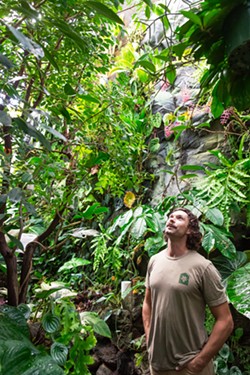Black pepper from the Malabar coast of southern India and the coveted Hawaiian koa plant are much closer to San Luis Obispo County residents than they might think.
These exotic plants' proximity is all thanks to the Cal Poly Plant Conservatory run by the Bailey College of Science and Mathematics' botany department. For the first time since construction broke ground in 2020, the prized collection of greenhouses opened to the public last fall.

Conservatory curator Gage Willey told New Times that the community-centric aspect of the business is his favorite element.
"Plant people really stick together, but conservatory people are a whole other niche," he said with a laugh.

- Photo By Jayson Mellom
- WACKY EXHIBIT One of the plants that visitors can check out in the Cal Poly Conservatory is the carnivorous pitcher plant that has a deep cavity filled with a digestive liquid.
Willey has been a plant aficionado for as long as he can remember. His infectious curiosity for all things flora propelled him to manage the five greenhouses. Willey was also the first to witness the blossoming of a giant corpse flower that had its debut bloom after 18 years.
Now, he draws from the wealth of conservatory plants to assist professors with practical experience for students.
"It's all self-guided," Willey said of the conservatory experience. "When the public does come in, they can feel very secure and comfortable in what's happening."
The conservatory's plants come from a networked bouquet of sources—the collection from the previous campus greenhouse and offerings from private collectors, hobbyists, botanical gardens like Pasadena's Huntington Gardens, and universities like UC Davis, UC Riverside, and CSU Fullerton.
Student efforts buttress the conservatory, led by Director Matt Ritter. Willey's student assistant, Julian, helps with watering and moving plants around before classes start. Interns meet for roughly two hours every week for training as part of their extracurricular program.
"My goal is to have them take over certain houses and they get some ownership over it," Willey said. "They'd completely maintain it under my direction."
Student volunteers also dedicate two hours a week to get hands-on with plants. They sign up in hordes, according to Willey.
"There's a real craving out there that I find really wonderful but also kind of sad because a lot of people just don't have that outlet in their daily life," he said.
Visitors should brace for a healthy sprinkling of water every 15 minutes inside the first greenhouse, called Warm Tropics, but it's hard to be annoyed when you're standing in the middle of a verdant "living museum." Willey added that he hopes to one day ramp up the immersive feel with speakers that blare sounds of thunder.
"Just like Rainforest Café!" he joked. "It's kinda like the Amazon Basin or Hawaii or southeast Asia where it's really nice and warm and humid and allows plants to express themselves to their full potential."
Three of the five greenhouses are open to the public—Warm Tropics, Cloud Forest, and Hot Desert. The other two are used by staff and students for propagation and germination.
During a recent tour inside Warm Tropics' balmy heat, Willey weaved through the small maze created by the plants—some possessing leaves almost as large as an adult human.
These lush plants thrive under a precise orchestra of heaters, sprinklers, fans, and greenhouse glass. The temperature is approximately 82 degrees with 80 percent humidity.
"This facility is meant to bring in both labs and lectures from Cal Poly and the public as well," he said. "The goal is to orient them to some of these climates and these environments and show how plants adapt and interact with each other."

- Photo By Jayson Mellom
- PASSION FOR PLANTS Gage Willey, the curator for the Cal Poly Plant Conservatory, admires plants in the Warm Tropics greenhouse—a space he monitors to ensure the right range of temperature and humidity.
Next door in the Cloud Forest greenhouse, the humidity escalates to a full 100 percent. The plants here are still tropical and found in the high elevation of mountains. They take up less greenhouse space than the ones in Warm Tropics, but they have a rich history worth visiting.
Willey drew attention to a slender, sickle-leafed tree called the acacia koa. It bears one of the most expensive woods in the world, desired for furniture and flooring. Conservatory Director Ritter procured seeds from professors in Hawaii a few years ago. One of those was planted on campus, became a tree, and produced its own seeds. Willey then germinated the second set of seeds for the conservatory.
"It was completely logged in the 1800s ... and a lot of the kings were trying to gain favor with the Europeans coming in," Willey said. "At the same time, all the Europeans were trying to use the Hawaiians for all their resources."
The tour ended with a stroll into the Hot Desert greenhouse. Its dry heat immediately envelopes you but it's designed for the dozens of cacti and other plants used to arid climates. One of them is a fat, squat succulent called the Euphorbia obesa that's sometimes called the basketball plant. It's native to South Africa.
"If you're in a desert, you'd want to take a bite out of it but you [shouldn't] do that," Willey said. "It would bleed out this white latex."
He demonstrated by cutting thin slashes into the plant along with some other longer cacti. Viscous, milky white resin trickled out of each gash.
"If you do touch it, don't touch your face! It will burn your eyes," Willey advised.
Willey has more conservatory plans in the pipeline beyond sensory experiences with plants. He wants to transform a portion of the outdoor arena to make a symbiotic community workspace. For a fee, people could drop in to learn skills like taking care of orchids, germinating seeds, and hiking to collect native seeds and process them to grow in residential backyards.
Until then, Willey welcomes students and the public to use the conservatory's open space—strewn with table and chairs—to work, relax, and enjoy their lunch.
"We usually have a pretty good culture in San Luis Obispo where people are just interested in things ... plus it's a public facility and so people are welcome to come in and look at stuff," Willey said. "That makes it feel more accessible." ∆
Reach Staff Writer Bulbul Rajagopal at [email protected].



Comments